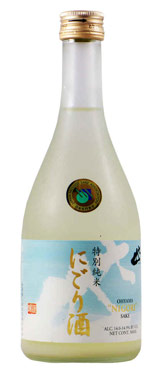A Wine Advice Column by Charles Fredy
 The first time people try sake, they may find it a bit too powerful. With alcohol levels of 15 to 20 percent, sake is almost as intense as a spirit. I think it is an acquired taste worth getting used to. Pure, expertly crafted sake is a great alternative to more traditional beverages. It’s a pity its versatility is often overlooked; it’s typically suggested only with Japanese cuisine. Move beyond this cultural pairing, and you’ll find an array of compatible offerings.
The first time people try sake, they may find it a bit too powerful. With alcohol levels of 15 to 20 percent, sake is almost as intense as a spirit. I think it is an acquired taste worth getting used to. Pure, expertly crafted sake is a great alternative to more traditional beverages. It’s a pity its versatility is often overlooked; it’s typically suggested only with Japanese cuisine. Move beyond this cultural pairing, and you’ll find an array of compatible offerings.
Ironically, sake doesn’t make a great pairing with rice — a staple of Asian cuisine. Perhaps that’s because sake begins as rice. Junmai sake has only four ingredients: rice, water, yeast and koji — a mold or spore that produces a variety of enzymes. Koji’s presence makes this sake highly compatible with pungent flavors such as strong, flavorful cheeses.
Despite its intensity, one of the intriguing aspects of sake is that it doesn’t get in the way of food flavors, so it blends nicely with hard-to-pair items, adding texture and enhancing rich, savory foods. The high acidity of quality sake is another reason it balances nicely with many cuisines.Junmai ginjo, for example, is wonderful with grilled or oily dishes such as tempura, grilled fish, spicy meat dishes, and many barbecue selections. Sake also matches the weight of chicken and meat preparations that incorporate sweet/tangy flavors.
Should sakes be served warm or chilled? Some do well at either temperature, but as a rule, pure, high-quality sake is best served chilled. While many low-tier sakes are served warm, I would rather warm something of junmai quality. Try a sake you like at various temperatures, so you can fine-tune your enjoyment and determine your favorite pairings.
Some recommendations: Nigori sake is unfiltered or coarse-filtered; some rice solids and lees remain after fermentation, creating a cloudy liquid. Shake before serving. A sake noted as junmai is made without neutral distilled spirit, and is a great starting point. Once you acquire the taste, try a more refined version of junmai ginjo, where 40 percent of the outer layer of the rice kernel is removed. Fermentation is slower and takes place at a lower temperature, creating complex flavors. Junmai daiginjo is labor-intensive to produce, but makes some of the finest sake, with more than 50 percent of the kernel removed. Such a sake can yield pleasant, fruity aromas and a delicate, fragrant flavor.
Sakes can vary quite a lot, depending on the producer. Experiment, and you’ll find that many are versatile. Here are some of my favorites:
Wakaebisu, Junmai, from Mie
Sawanoi, Junmai Ginjo, from Tokyo
Wakatake, Junmai Daiginjo, Onikoroshi, from Shizuoka
Ohyama, Nigori, from Yamagata
Kamikokoro, Specialty Sake, “Momo,” White Peach Sake from Okayama
Use a junmai ginjo in place of your favorite vodka or gin; it makes a great cocktail.
Here’s a sake cocktail recipe:
- 3 oz. nigori sake
- 1 oz. pineapple juice
- 1 oz. ginger simple syrup (Monin or fresh)
- squeeze of lime





